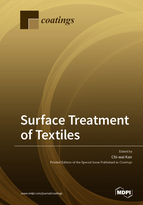Surface Treatment of Textiles
A special issue of Coatings (ISSN 2079-6412).
Deadline for manuscript submissions: closed (31 July 2021) | Viewed by 24731
Special Issue Editor
Interests: safety and health management; environmental management; textile product evaluation; textile testing instrumentation
Special Issues, Collections and Topics in MDPI journals
Special Issue Information
Dear Colleagues,
Textiles are commonly constituted of natural and synthetic fibers for normal applications. In order to impart functional or aesthetic effects on the textiles, the surface characteristics in the fiber play an important role. Therefore, surface treatment or modification is a possible way to provide value-added properties to textiles. The textile material/fiber surface can be treated or modified physically and/or chemically in order to achieve different desired effect.
This Special Issue will provide an open forum to draw the attention of academic researchers and industrial experts to look into different aspects of the surface treatment of textiles. Topics in this Special Issue will include articles related, but not limit to: (i) physical surface treatment of textiles and (ii) chemical surface treatment of textiles, for potential textile applications. Articles including but not limited to reviews, full papers, short notes, and communications are welcome for submission to this Special Issue.
In particular, the topics of interest include, but are not limited to:
- Surface treatment;
- Physical treatment;
- Chemical treatment;
- Textiles;
- Fibers;
- Functional properties.
Prof. Chi-wai Kan
Guest Editor
Manuscript Submission Information
Manuscripts should be submitted online at www.mdpi.com by registering and logging in to this website. Once you are registered, click here to go to the submission form. Manuscripts can be submitted until the deadline. All submissions that pass pre-check are peer-reviewed. Accepted papers will be published continuously in the journal (as soon as accepted) and will be listed together on the special issue website. Research articles, review articles as well as short communications are invited. For planned papers, a title and short abstract (about 100 words) can be sent to the Editorial Office for announcement on this website.
Submitted manuscripts should not have been published previously, nor be under consideration for publication elsewhere (except conference proceedings papers). All manuscripts are thoroughly refereed through a single-blind peer-review process. A guide for authors and other relevant information for submission of manuscripts is available on the Instructions for Authors page. Coatings is an international peer-reviewed open access monthly journal published by MDPI.
Please visit the Instructions for Authors page before submitting a manuscript. The Article Processing Charge (APC) for publication in this open access journal is 2600 CHF (Swiss Francs). Submitted papers should be well formatted and use good English. Authors may use MDPI's English editing service prior to publication or during author revisions.






